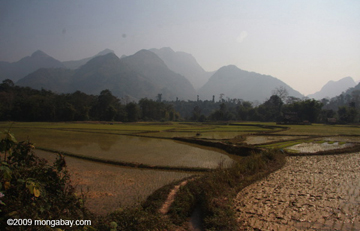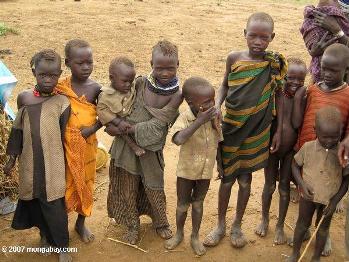If swift action is not taken to prepare farmers in the developing world for hotter, drier, shorter growing seasons, climate change may threaten the lives of hundreds of millions of people by 2050. People in Africa and South Asia are particularly at risk of further impoverishment and hunger in a warmer world. According to the UN, a billion people are already going hungry worldwide.
Responding to pressing evidence that climate change will affect the world’s poor disproportionately, the CGIAR Research Program on Climate Change, Agriculture, and Food Security’s (CCAFS) new report, Mapping Hotspots of Climate Change and Food Insecurity in the Global Tropics, details likely locations of future food insecurity due to climate change. The reports also recommends agricultural adaptations that could be made now to prevent widespread hunger in the future.
By overlaying historically food-insecure areas with expected “hotspot” zones—regions likely to be very affected by climate change—CGIAR maps predict food yields will drop sharply in some areas that rely heavily on local agriculture within 40 years. As temperatures rise, these agricultural regions will cross “climate thresholds” past which staple crops like beans and maize will fail to thrive or even grow.
 How will these rice fields in Laos do in an age of climate change. Photo by: Rhett A. Butler. |
“These are areas highly exposed to climate shifts, where survival is strongly linked to the fate of regional crop and livestock yields, and where survival is strongly linked to the fate of regional crop and livestock yields, and where chronic food problems indicate that farmers are already struggling and they lack the capacity to adapt to new weather patterns,” explains Polly Ericksen, a senior researcher with CGIAR.
Experts label a population food-insecure, meaning that people are chronically hungry, if more than 40 percent of children under the age of five suffer stunted growth by World Health Organization (WHO) standards.
The effects of climate change on agriculture could devastate sweeping areas in South Asia—including all of India—and parts of West Africa. Even today, 369 million people suffer from hunger in these agricultural areas, which CGIAR predicts will see a 5 percent decrease in their growing season length by 2050. Temperatures during the growing seasons in these regions are likely to exceed 86 degrees Farenheit (30 degrees Celsius). Even with optimal rainfall, beans may not grow at these temperatures, and maize and rice yields would likely suffer.
Populations in Latin America are at risk of climate-induced food scarcity as well, but CGIAR believes they will be better prepared than Africa or South Asia because Latin America is relatively food secure at present. However, concern remains: millions in Latin America are almost exclusively dependant on local production and are living in areas likely to be highly affected by climate change. In fact, by 2050 excellent growing conditions may drop below 120 days per season in northeast Brazil and in Mexico, where populations are heavily reliant on farming and conditions for staple crops are already fragile.
Researchers in agricultural science, international development, and climatology are working to prepare farmers in the developing world to make the adaptations needed for changing climate conditions. Farmers, who already adapt to changing weather patterns, may not be able to cope with predicted climate change.
 Struggling with water and food insecurity, the Turkana people of northern Kenya are already facing climate impacts. Photo by: Rhett A. Butler. |
“What this study suggests is that the speed of climate shifts and the magnitude of the changes required to adapt could be much greater [than previously]. In some places, farmers might need to consider entirely new crops or new farming systems,” explains CGIAR scientist Patti Kristjanson.
Crop breeders with the project are developing “climate ready” varieties of staple crops that can thrive under stressful conditions. However, they warn this might not be enough. Maize is East and Southern Africa’s staple crop, but if temperatures rise as predicted, researchers recommend that farmers switch to heartier cassava or sorghum. With increased risk of lower crop yields or even crop failure accompanying climate change, farmers in parts of the developing world will need to diversify by integrating livestock and agroforestry into their agricultural systems.
Tropical countries should also be prepared to increase their trade in agricultural commodities as a way of bridging the gap between domestic production and food needs the report suggests. The food price spikes of 2008 and 2010 illustrated that food security matters are international in scope and require global consideration. However, the rise in commodity prices is also linked to hikes in deforestation, which itself contributes to climate change through greenhouse gas emissions.
“The window of opportunity to develop innovative solutions that can effectively overcome these challenges is limited,” asserts Philip Thorton, who co-authored the report, “Major adaptation efforts are needed now if we are to avoid serious food security and livelihood problems later.”
Related articles
Rising food prices threaten to push over 60 million Asians back into poverty
(04/27/2011) The Asian Development Bank has warned that high food prices on the continent could push 64 million people in developing countries into extreme poverty, reports the AFP.
Food prices hit new record high—again
(03/03/2011) Food prices in February hit a new record, breaking the previous one set in January and continuing an eight-month streak of rising prices, according to the Food and Agriculture Organization (FAO). Experts fear that rising food prices could lead to another food crisis similar to that of 2007-2008.
Numerous causes, including climate change, behind record food prices
(02/07/2011) Food prices hit a record high in January according to the UN’s Food and Agriculture Organization (FAO), threatening the world’s poor. Rising 3.4% since December, the FAO stated that prices reached the highest point since the agency began tracking food prices in 1990. Given the complexity of world markets and agriculture, experts have pointed to a number of reasons behind the rise including rising meat and dairy consumption, the commodity boom, fresh water scarcity, soil erosion, biofuels, growing human population, and a warming world that has exacerbated extreme weather events like last year’s heatwave in Russia.